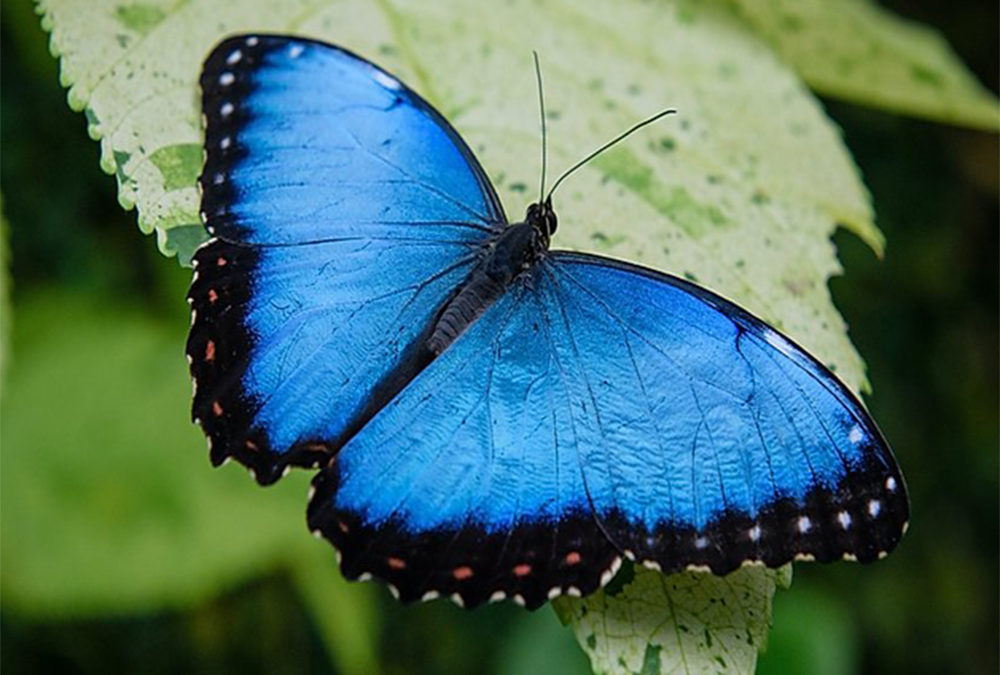When you look outside, your eyes are met by the stunning colors of nature: emerald grass, mocha tree bark, electric-yellow caterpillars, wine-red berries. Many of these lush hues common to nature are derived from biological color pigments that come from pigment-containing cells called chromatophores. There are many types of chromatophores, including melanophores (black), erythrophores (red), xanthophores (yellow), and leucophores (white). Aside from chromatophores, there are other common biological pigments such as beta-carotene (orange) and melanin (dark brown).
Surprisingly, not all natural color is derived from these biological pigments. Some colors are a result of structure. Structural color is color derived from the nanostructure of a surface. This occurs when the nanostructure of a surface acts like a prism, interacting with light waves. Depending on the nanostructure, certain light wavelengths can be amplified (constructive interference), while other light wavelengths are diminished (destructive interference). This results in the cancelling out of most colors and the expression of one bold color.
A particularly interesting example of structural color is found in the Morpho butterfly. The Morpho butterfly appears to be a beautiful, iridescent blue color.
Instead of coming from a chromatophore or other biological pigment, the Morpho’s blue comes from the specific Morpho wing nanostructure. This nanostructure, when looking at the wing from the surface-up view, seems to resemble many trees standing next to each other. These tree-like structures cause light waves to diffract as they hit the surface. When the diffracted light waves bump into each other, some colors (certain nanometer-length light waves) cancel out, while others are amplified. In the case of the Morpho butterfly, a rich blue color is amplified.
Because the color of the Morpho wings is dictated by the light waves’ interaction with the surface nanostructure, when the Morpho’s wings are rotated away from the light, they become clear and transparent (a result of no light waves hitting the wing’s nanostructure). This structural color also accounts for the iridescence of the Morpho wing; because as the wing is viewed from different angles, different alignments of the wing’s nanostructure occur. Each angle’s interaction with the light causes slightly different interferences and amplifications. Therefore, slightly different shades and colors are present at different angles.
The functional and complex nanostructures of the Morpho have been studied and emulated by scientists and innovators from the Berkeley-based company Cypris Materials. The solution Cypris Materials came up with offers a wide range of applications for structural color in the form of paints. Their paints start as two different combinations of clear/white crystals. These crystals will end up forming blue (based off of the Morpho butterfly) and red solid polymers. To develop the paint, these crystals are mixed with an organic solvent until they dissolve into a clear looking paint. Next, these clear looking paints are applied to a surface. As the paints dry, the solvent dissolves, and the solid polymers form a nanostructure that acts like the wing of a Morpho butterfly, providing blue or red structural color.
Because Cypris Materials has mastered red and blue colors, it can create all of the colors of the rainbow by combining the two types of crystals that form blue and red solids in different ratios before adding the combinations to the solvent. Depending on the ratio, the combinations can result in orange, yellow, green, or purple.
Cypris paints come in brush paint and spray paint form and can be used to coat anything from a canvas to the walls of a house. These paints, due to their structural color, eliminate the need for pigments and dyes, which are created with inorganic pigments that can have extremely harmful effects on humans (damage to organ systems, damage to the nervous system, increased likelihood of developing skin cancer). As a result, Cypris paints are very eco-friendly, sustainable, and healthy for the consumer.
In addition to colored paints, Cypris Materials has tuned its coatings to create clear coatings that reflect infrared light (905nm). If applied to the road, these coatings can allow Autonomous Driving Vehicles (ADVs) to safely and easily detect black and dark colored objects, because they will be able to pick up the highly reflective infrared light. When left without any coating, black and dark objects normally do not reflect light well (they reflect under 10% of light), which causes ADVs to struggle to sense them. Cypris coatings can help eliminate the danger of nighttime ADV driving.
Cypris’ clear coating can also be tuned to reflect near infrared light (700-1400nm). When painted onto windows, this coating improves the windows’ energy-efficiency. Likewise, the coating can be painted onto roof shingles to “create heat-reflective roofing shingles that maintain their aesthetic appearance”. These applications can “dramatically reduce cooling loads in warm climates, saving energy and lowering electricity bills”. Cypris Materials offers a real solution to toxic pigments and dyes, with sustainable, safe, and energy-efficient structural paints and coatings.
Now that the foundation of mimicking structural color for sustainability and energy efficiency has been created, structural color will begin to permeate our world as a part of many new technologies. So, next time you walk outside to explore the nature that surrounds you, look deeper. Enjoy the magnificently bold colors of nature and ponder their pigments and structure. Think of what nature is doing here, and ask yourself: what more could come of utilizing structural color in our designs? How might we take this genius strategy and color our world like nature does?

 Faye Berry is a rising senior at Lower Merion High School in Pennsylvania. She has enjoyed nature from a young age and continues to explore the world around her.
Faye Berry is a rising senior at Lower Merion High School in Pennsylvania. She has enjoyed nature from a young age and continues to explore the world around her.

